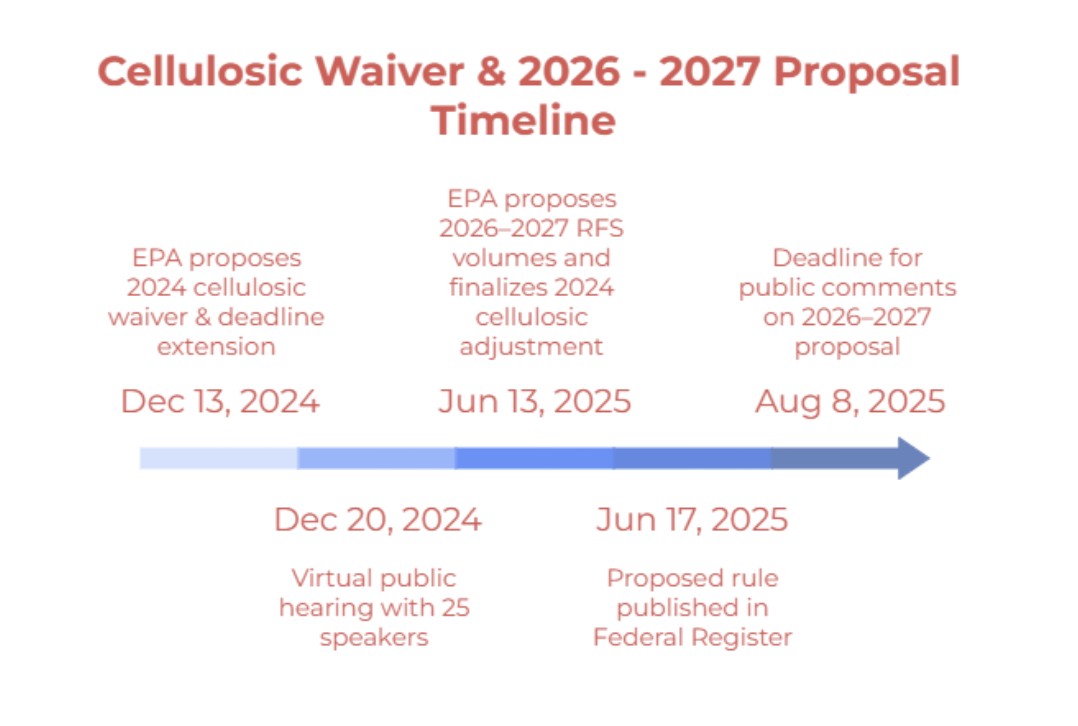On June 13, 2025, the EPA issued a proposed rule establishing Renewable Volume Obligations (RVOs) for 2026 and 2027, along with a finalized reduction to the 2024 cellulosic biofuel target. Earlier this week, RINSTAR published a detailed breakdown of both the proposed rule and the finalized waiver. The announcement prompted a broad spectrum of responses across the renewable fuels industry—ranging from strong support within the agriculture and ethanol sectors to significant concern among renewable natural gas (RNG) and biogas stakeholders. A summary of those reactions is provided below.

Strong Support from Agriculture and Biofuels Industry
Agricultural groups and ethanol producers welcomed the proposed RVO increases, seeing them as a long-awaited recognition of the industry’s vital role in promoting clean energy and supporting economic growth in rural communities.
The American Farm Bureau Federation commended the proposal for recognizing farmers’ contributions to reducing greenhouse gas emissions and promoting U.S. energy independence. American Farm Bureau Federation President Zippy Duvall commented “Farm Bureau applauds the Environmental Protection Agency and Administrator Lee Zeldin for recognizing the importance of biofuels for farmers and America’s families. EPA’s proposed Renewable Fuel Standard for 2026 and 2027 would increase domestic biofuel production, prioritize home-grown crops, and enable producers to meet the demands of emerging international markets. America’s families who choose to use biofuels could see much-needed relief at the gas pump, with savings of 10 to 30 cents per gallon.” Similarly, the National Farmers Union expressed optimism, stating the rule could unlock meaningful opportunities for American producers to drive progress on national renewable energy goals. National Farmers Union (NFU) President Rob Larew released the following statement “We’re pleased the EPA is prioritizing American farmers and ranchers by raising biomass-based diesel volumes and focusing on domestic feedstocks. These proposed Renewable Volume Obligations will create meaningful opportunities for our U.S. producers to contribute to our renewable energy goals and ensure they see the full benefits of renewable fuel production. We look forward to working with the administration as it finalizes these rules to ensure they continue to expand opportunities for family farmers and ranchers.”
Elected officials from agricultural states also weighed in positively. Representative Adrian Smith (R–NE) applauded the proposed volumes, noting the economic benefits for both farmers and consumers. Representatives Ashley Hinson and Mariannette Miller-Meeks (R–IA) noted the proposal would strengthen American energy dominance, while Representative Dusty Johnson (R–SD) called the move “great news” for biofuels producers and the broader rural economy. Senator Deb Fischer echoed these sentiments, highlighting the recognition of agriculture’s role in energy security.
Meanwhile, the Engine Technology Forum called the proposal a “strong, growth-oriented policy” that supports the long-term health of the renewable fuels industry.
Industry Applauds Growth in Biomass-Based Diesel
Biofuel producers and ethanol industry advocates were especially encouraged by the significant increases in the biomass-based diesel targets. Coverage from Ethanol Producer Magazine and AgWeb emphasized the leap in blending mandates—from 3.35 billion gallons in 2025 to 5.61 billion gallons in 2026—as a potential game-changer for U.S. farmers and biodiesel producers. Many in the industry believe these targets provide needed stability and growth potential after years of inconsistent policy direction.
Clean Fuels Alliance America also welcomed the proposed rule. “Today’s RFS proposal is a welcome and timely signal to U.S. biodiesel, renewable diesel and SAF producers as well as America’s farmers and agricultural businesses,” said Kurt Kovarik, vice president of federal affairs at Clean Fuels.
Concerns from the RNG and Biogas Community
While the overall reception was largely positive within traditional biofuel circles, the reaction from the RNG and biogas sector was far more critical. The American Biogas Council expressed deep concern over the revised 2024 cellulosic target and the proposed 2026–2027 cellulosic volumes. American Biogas Council (ABC) Executive Director Patrick Serfass issued the following statement “The ABC is disappointed by EPA’s proposal, which reduces the growth of cellulosic biofuels under the RFS. The proposed D3 RVO cuts growth in half, two years in a row, down to 5% annual growth, ignoring the demonstrated 20-30% growth of D3 fuel production.” Serfass also stated that “this proposal is not a win for all farmers. In particular, dairy and other livestock farmers are the most harmed. The RFS supports these communities through steady income generated from converting their waste to renewable fuel. This misalignment is particularly surprising given the Administration’s welcome, outspoken support for American farmers and the natural gas industry.”
A Waste Dive article echoed these concerns , quoting Stillwater Associates’ Adam Schubert, who pointed out the challenges RNG producers face in generating RINs without sufficient end-use vehicles in the market. The article also noted that the EPA is adjusting its forecasting methodology to more accurately reflect industry capabilities, in an effort to avoid overestimating production volumes and triggering waiver provisions, as has occurred in previous years.
Balancing Growth and Realism
Overall, many see the EPA’s proposed RFS volumes and updated approach as a step in the right direction—striking a balance between expanding renewable fuel use and acknowledging the current limitations of cellulosic production. While the proposal brings good news for conventional and advanced biofuels, it leaves the biogas sector hoping for stronger support and a more prominent role moving forward.
What’s Next?
The EPA will host virtual public hearings on July 8–9 , providing an opportunity for stakeholders across the renewable fuel value chain to share input. Final rules are expected to be issued later this year following the close of the public comment period.
Anyone interested in attending the hearings—including those who do not plan to speak—must register by emailing RFS-Hearing@epa.gov. Please note that a separate registration must be submitted for each attendee, and the EPA has requested that all registrations be completed by July 1, 2025 .
Link to information on the hearing regarding the proposal can be found here.
At RINSTAR, we’ve been following the Renewable Fuel Standard for over 15 years, and we’re passionate about helping you stay informed as the program continues to evolve. Check out our latest blog posts for helpful updates, and be sure to subscribe to our newsletter so you never miss a beat in the world of renewable fuels.
